Related Research Articles

The ecliptic or ecliptic plane is the orbital plane of Earth around the Sun. From the perspective of an observer on Earth, the Sun's movement around the celestial sphere over the course of a year traces out a path along the ecliptic against the background of stars. The ecliptic is an important reference plane and is the basis of the ecliptic coordinate system.
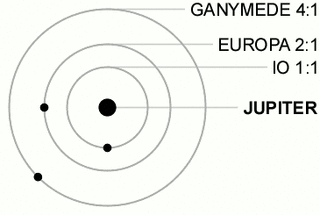
In celestial mechanics, orbital resonance occurs when orbiting bodies exert regular, periodic gravitational influence on each other, usually because their orbital periods are related by a ratio of small integers. Most commonly, this relationship is found between a pair of objects. The physical principle behind orbital resonance is similar in concept to pushing a child on a swing, whereby the orbit and the swing both have a natural frequency, and the body doing the "pushing" will act in periodic repetition to have a cumulative effect on the motion. Orbital resonances greatly enhance the mutual gravitational influence of the bodies. In most cases, this results in an unstable interaction, in which the bodies exchange momentum and shift orbits until the resonance no longer exists. Under some circumstances, a resonant system can be self-correcting and thus stable. Examples are the 1:2:4 resonance of Jupiter's moons Ganymede, Europa and Io, and the 2:3 resonance between Neptune and Pluto. Unstable resonances with Saturn's inner moons give rise to gaps in the rings of Saturn. The special case of 1:1 resonance between bodies with similar orbital radii causes large planetary system bodies to eject most other bodies sharing their orbits; this is part of the much more extensive process of clearing the neighbourhood, an effect that is used in the current definition of a planet.

Precession is a change in the orientation of the rotational axis of a rotating body. In an appropriate reference frame it can be defined as a change in the first Euler angle, whereas the third Euler angle defines the rotation itself. In other words, if the axis of rotation of a body is itself rotating about a second axis, that body is said to be precessing about the second axis. A motion in which the second Euler angle changes is called nutation. In physics, there are two types of precession: torque-free and torque-induced.

Tidal acceleration is an effect of the tidal forces between an orbiting natural satellite and the primary planet that it orbits. The acceleration causes a gradual recession of a satellite in a prograde orbit, and a corresponding slowdown of the primary's rotation. The process eventually leads to tidal locking, usually of the smaller body first, and later the larger body. The Earth–Moon system is the best-studied case.

Geophysics is a subject of natural science concerned with the physical processes and physical properties of the Earth and its surrounding space environment, and the use of quantitative methods for their analysis. Geophysicists, who usually study geophysics, physics, or one of the Earth sciences at the graduate level, complete investigations across a wide range of scientific disciplines. The term geophysics classically refers to solid earth applications: Earth's shape; its gravitational, magnetic fields, and electromagnetic fields ; its internal structure and composition; its dynamics and their surface expression in plate tectonics, the generation of magmas, volcanism and rock formation. However, modern geophysics organizations and pure scientists use a broader definition that includes the water cycle including snow and ice; fluid dynamics of the oceans and the atmosphere; electricity and magnetism in the ionosphere and magnetosphere and solar-terrestrial physics; and analogous problems associated with the Moon and other planets.

In astronomy, axial precession is a gravity-induced, slow, and continuous change in the orientation of an astronomical body's rotational axis. In the absence of precession, the astronomical body's orbit would show axial parallelism. In particular, axial precession can refer to the gradual shift in the orientation of Earth's axis of rotation in a cycle of approximately 26,000 years. This is similar to the precession of a spinning top, with the axis tracing out a pair of cones joined at their apices. The term "precession" typically refers only to this largest part of the motion; other changes in the alignment of Earth's axis—nutation and polar motion—are much smaller in magnitude.
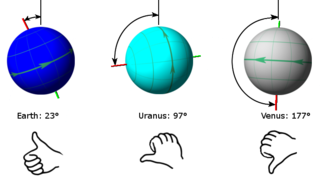
In astronomy, axial tilt, also known as obliquity, is the angle between an object's rotational axis and its orbital axis, which is the line perpendicular to its orbital plane; equivalently, it is the angle between its equatorial plane and orbital plane. It differs from orbital inclination.
In astronomy, an epoch or reference epoch is a moment in time used as a reference point for some time-varying astronomical quantity. It is useful for the celestial coordinates or orbital elements of a celestial body, as they are subject to perturbations and vary with time. These time-varying astronomical quantities might include, for example, the mean longitude or mean anomaly of a body, the node of its orbit relative to a reference plane, the direction of the apogee or aphelion of its orbit, or the size of the major axis of its orbit.
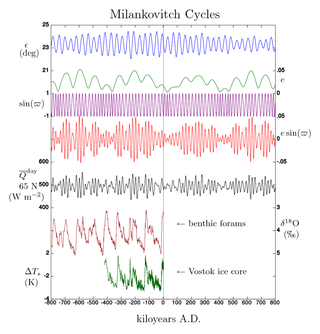
Milankovitch cycles describe the collective effects of changes in the Earth's movements on its climate over thousands of years. The term was coined and named after the Serbian geophysicist and astronomer Milutin Milanković. In the 1920s, he hypothesized that variations in eccentricity, axial tilt, and precession combined to result in cyclical variations in the intra-annual and latitudinal distribution of solar radiation at the Earth's surface, and that this orbital forcing strongly influenced the Earth's climatic patterns.
A synodic day is the period for a celestial object to rotate once in relation to the star it is orbiting, and is the basis of solar time.
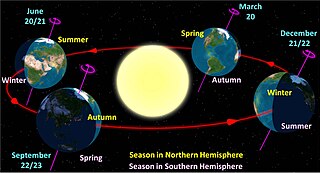
Earth orbits the Sun at an average distance of 149.60 million km (92.96 million mi), or 8.317 light-minutes, in a counterclockwise direction as viewed from above the Northern Hemisphere. One complete orbit takes 365.256 days, during which time Earth has traveled 940 million km (584 million mi). Ignoring the influence of other Solar System bodies, Earth's orbit, also called Earth's revolution, is an ellipse with the Earth–Sun barycenter as one focus with a current eccentricity of 0.0167. Since this value is close to zero, the center of the orbit is relatively close to the center of the Sun.

In astronomy, perturbation is the complex motion of a massive body subjected to forces other than the gravitational attraction of a single other massive body. The other forces can include a third body, resistance, as from an atmosphere, and the off-center attraction of an oblate or otherwise misshapen body.
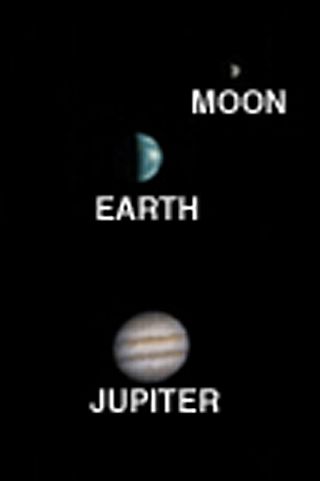
Many astronomical phenomena viewed from the planet Mars are the same as or similar to those seen from Earth; but some are quite different. For example, because the atmosphere of Mars does not contain an ozone layer, it is also possible to make UV observations from the surface of Mars.

The proper orbital elements or proper elements of an orbit are constants of motion of an object in space that remain practically unchanged over an astronomically long timescale. The term is usually used to describe the three quantities:

The Moon orbits Earth in the prograde direction and completes one revolution relative to the Vernal Equinox and the stars in about 27.32 days and one revolution relative to the Sun in about 29.53 days. Earth and the Moon orbit about their barycentre, which lies about 4,670 km (2,900 mi) from Earth's centre, forming a satellite system called the Earth–Moon system. On average, the distance to the Moon is about 385,000 km (239,000 mi) from Earth's centre, which corresponds to about 60 Earth radii or 1.282 light-seconds.
The semi-analytic planetary theory VSOP is a mathematical model describing long-term changes in the orbits of the planets Mercury to Neptune. The earliest modern scientific model considered only the gravitational attraction between the Sun and each planet, with the resulting orbits being unvarying Keplerian ellipses. In reality, all the planets exert slight forces on each other, causing slow changes in the shape and orientation of these ellipses. Increasingly complex analytical models have been made of these deviations, as well as efficient and accurate numerical approximation methods.
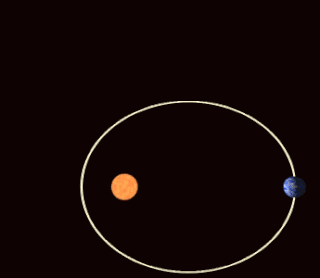
In celestial mechanics, apsidal precession is the precession of the line connecting the apsides of an astronomical body's orbit. The apsides are the orbital points farthest (apoapsis) and closest (periapsis) from its primary body. The apsidal precession is the first time derivative of the argument of periapsis, one of the six main orbital elements of an orbit. Apsidal precession is considered positive when the orbit's axis rotates in the same direction as the orbital motion. An apsidal period is the time interval required for an orbit to precess through 360°, which takes the Earth about 112,000 years and the Moon about 8.85 years.
A tropical year or solar year is the time that the Sun takes to return to the same position in the sky – as viewed from the Earth or another celestial body of the Solar System – thus completing a full cycle of astronomical seasons. For example, it is the time from vernal equinox to the next vernal equinox, or from summer solstice to the next summer solstice. It is the type of year used by tropical solar calendars.
This glossary of astronomy is a list of definitions of terms and concepts relevant to astronomy and cosmology, their sub-disciplines, and related fields. Astronomy is concerned with the study of celestial objects and phenomena that originate outside the atmosphere of Earth. The field of astronomy features an extensive vocabulary and a significant amount of jargon.
Astronomical nutation is a phenomenon which causes the orientation of the axis of rotation of a spinning astronomical object to vary over time. It is caused by the gravitational forces of other nearby bodies acting upon the spinning object. Although they are caused by the same effect operating over different timescales, astronomers usually make a distinction between precession, which is a steady long-term change in the axis of rotation, and nutation, which is the combined effect of similar shorter-term variations.
References
- ↑ "secular (adj.)". Etymology Online.
- ↑ "secular, adj. and n.". Oxford English Dictionary.
- ↑ Jyri B. Kolesnik; Revision of the tidal acceleration of the Moon and the tidal deceleration of the Earth's rotation from historical optical observations of planets, in ISBN 2-901057-45-4 (2001) pp. 231–234.
- ↑ Lowrie, William (2004). Fundamentals of Geophysics. Cambridge University Press. ISBN 978-0-521-46164-1.
- ↑ Jurij B. Kolesnik; A new approach to interpretation of the non-precessional equinox motion, in Journées 2000 – systèmes de référence spatio-temporels. J2000, a fundamental epoch for origins of reference systems and astronomical models, Paris, Septembre 2000, edited by N. Capitaine, Observatoire de Paris (2001), pp. 119–120. ISBN 2-901057-45-4
- ↑ Bretagnon, P. (1982). "Théorie du mouvement de l'ensemble des planètes. Solution VSOP82". Astronomy & Astrophysics . 114: 278–288. Bibcode:1982A&A...114..278B.
- ↑ Edwards, R.; McGee, J.; Bessetti, W. H. C. (2007). Technical Analysis of Stock Trends. CRC Press. p. 17. ISBN 978-0-8493-3772-7.
- ↑ Merrill, Ronald T.; McElhinny, Michael W.; McFadden, Phillip L. (1996). The Magnetic Field of the Earth: Paleomagnetism, the Core, and the Deep Mantle. International Geophysics Series. Vol. 63. Academic Press. ISBN 9780124912458.
- ↑ Okasha, M; McCarron, P; McEwen, J; Smith, GD (2001). "Age at menarche: secular trends and association with adult anthropometric measures". Annals of Human Biology . 28 (1): 68–78. doi:10.1080/03014460150201896. PMID 11201332.
- ↑ Wattigney, WA; Srinivasan, SR; Chen, W; Greenlund, KJ; Berenson, GS (1999). "Secular trend of earlier onset of menarche with increasing obesity in black and white girls: the Bogalusa Heart Study". Ethnicity & Disease. 9 (2): 181–189. PMID 10421080.
- ↑ Prentice, S; Fulford, AJ; Jarjou, LM; Goldberg, GR; Prentice, A (2010). "Evidence for a downward secular trend in age of menarche in a rural Gambian population". Annals of Human Biology . 37 (5): 717–721. doi:10.3109/03014461003727606. PMC 3575631 . PMID 20465526.
- ↑ Biro, Frank; Galvez, MP; Greenspan, LC; Succop, PA; Vangeepuram, N (Sep 2010), "Pubertal assessment method and baseline characteristics in a mixed longitudinal study of girls", Pediatrics, 126 (3): e583–90, doi:10.1542/peds.2009-3079, PMC 4460992 , PMID 20696727
- ↑ Euling, Susan; Herman-Giddens, Marcia; Lee, Peter; Selevan, Sherry (February 2008). "Examination of US Puberty-Timing Data from 1940 to 1994 for Secular Trends: Panel Findings". Pediatrics. 121 (3).